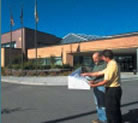
Public Facility Planning
Definition of a Public Facility
A public facility is defined as a building in which government operations or activities occupy more than 4,000 square feet, a dedicated park exceeding 1.5 acres, a street of collector or greater capacity, or a snow disposal site.
Site Selection and Site Plan Review
Municipal land use regulations (Title 21) require that the Planning and Zoning Commission review proposed site selections for public facilities such as fire stations, schools and libraries. The Commission reviews plans for consistency with the goals, policies and land use designations of the Comprehensive Plan and other municipal plans adopted by the Assembly, as well as conformity with Title 21. Municipal regulations also require the the Urban Design Commission review proposed public facility project site plans.
Role of the Long-Range Planning Division
Long-Range Planning assists with site selections for a variety of public facilities. The division may coordinate the review process, meet with the agency and its design consultants to determine how the project may best conform to code requirements, and prepare the department's recommendation to the Planning and Zoning Commission. In some cases, Long-Range Planning prepares or assists with the site selection final report for review by the Commission. The Commission considers the effects of a site proposal on the surrounding area. The type, size, number, and location are important factors in the distribution of such facilities in a growing and changing community.
Long-Range Planning also assists with public facility site plan reviews. Staff considers off-site impacts of the facility site plan, pedestrian and vehicular traffic circulation and safety, and efficient public use, among other factors. The Urban Design Commission reviews public facility site plans based on these and other planning and design considerations. The Zoning and Platting Division generally prepares the department review for these site plans.